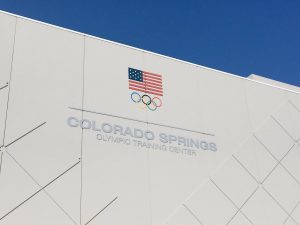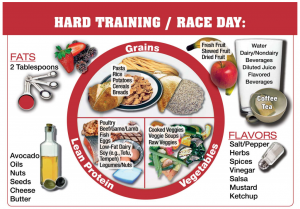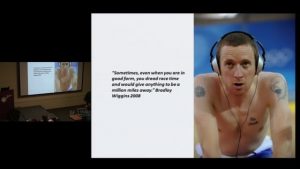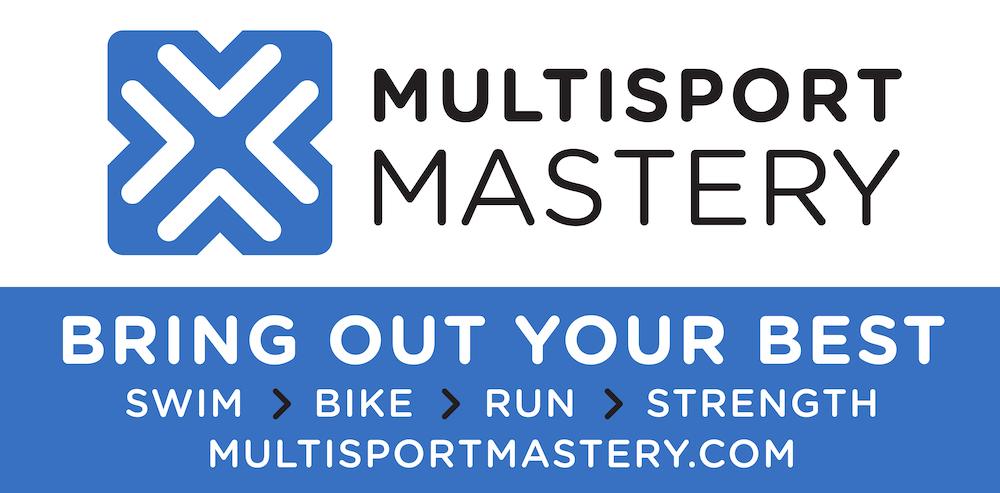This past week, I spent 4 days at USA Triathlon’s Endurance Coach certification program in Colorado Springs. I wanted to share some of the highlights of my experience.

Like you, when I hear “Olympic Training Center in Colorado Springs” I imagine a state of the art training facility nestled into the majestic Rockies. Instead, you drive by what from the outside looks like a gated compound amidst a busy urban intersection of auto parts stores, Taco Bells and gas stations.
Scenic it is not!
But look closer and you see the Olympic rings adorning multiple buildings that house Wrestling. Weightlifting, The swimming hall. The shooting center. Walkways lined with flags. Pictures of past medalists. Motivational quotes. It’s hard to walk through the OTC without feeling inspired.
Day one started with a talk by Alicia, one of the USOC sports dieticians. Alicia’s message was simple and evidence-based. In her words, always go back to the basics. Start by thinking about the function of food (energy, recovery, repair, growth, thermoregulation, reproduction). Then, think about using fuel for optimal performance by way of proper energy availability, hydration, supporting energy metabolism, improving muscle strength, maintaining bone density, supporting immune system integrity. When it comes to teaching athletes, she said it’s best to use visuals – not numbers. Telling an athlete to eat a serving a protein is less effective then showing them.

Alicia talked about the role of glycogen and how in endurance sports, glycogen is the limiting factor. In discussing carbohydrates, she stated they are the most efficient form of energy. And if your performance goal is not performance, limit carbohydrate (read that again, folks). She emphasized the importance of restocking glycogen in the recovery window. As for recovery nutrition, she prefers real food to get in 20g of protein plus 1 gram of carbohydrate for every 1 kg of body weight. Being endurance athletes with multiple workouts a day, she stated the importance of recovering after every workout to promote better eating overall. She also defined the recovery window as “ASAP” versus the traditional 30 minute post-workout (in her words, if you tell an athlete they have 30 minutes, they will wait 30 minutes and then eat).
Alicia then talked about supplements. The first thing she asks with a supplement: is it safe? Remember, the FDA does not regulate supplements. If it works, there’s plenty of research about it and behind it. But rather than use supplements, she reiterated the importance of eating well. In her view, you need to earn the right to use supplements; performance enhancement starts with a proper diet.
Alicia reviewed proper hydration – how most athletes are dehydrated and do not realize its impact. With as little as 2% loss, performance will be compromised. Hydration is critical for delivery and recovery (by way of excretion). She gave us her secret tip for how to improve athlete hydration. Let’s just say I’m excited to launch my own trial with the 2017 Ironman Wisconsin Training Program at Well-Fit!
Next up was Bobby McGee’s presentation on run training and pacing in long course. Bobby is the run advisor to many Olympians (including Gwen!). His presentations are always full of interesting information as well as nuggets from his own experience.
- The run is a very internal conversation. You cannot compare or look at others around you.
- Many doing long course will disconnect how they feel and what they need to do.
- Most athletes will be either centrally (engine) limited or peripherally (form) limited.
- No one negative splits a marathon; go out at an even pace.
- You need to train how to fast walk; many cramp while walking in an IM because they are not prepared.
- Look at your fatigue index (how much do you slow down when doubling the distance; elites typically slow down by 3% – ie., double their 5K time & compare to actual 10K time, it will be < 3%).
- Most women are power limited. Most men are heat management & energy limited.
- Power is critical for long course racing (not just endurance).
- Training goal is to make the cardiovascular system efficient but also must be able to resist fatigue & prepare fascia of the legs to withstand stress.
- If someone is “engine”-limited; work a variety of paces.
- If someone is “form”-limited; work at a slower pace to prepare the connective tissue.
- Our relationship with food/fuel during a race changes how it acts in the body (research supports this)
- Pros are obsessed with going fast. Age groupers are obsessed with how they look. (think about that!)
- Better to overdo your taper than underdo it.
- When selecting pace capability, remember: expectation vs reality
- Know your open run abilities & how fast you CAN run by doing open run races (5K, 10K, 10 miler, ½ mary)
- At 65 degrees, climactic influences on pace are significant.
- Don’t base goals on your “mythical or once former self.”
- Quality run training is still important in long course racing (pertains to placement of long run & type of running you’ll do).
- If you want to improve your run, you cannot always run fatigued, you must run fresh.
- Learn to adapt proactively to conditions (look at weather forecast & be brave enough to say “today is not a PR day”).
- Most run injuries are caused by biking (make sure you have a proper fit, shoe, pedal system & cleat placement).
Later in the afternoon, we heard from one of the USOC sports psychologists, Peter Haberl. This one really connected with me (and reminded me of many of the principles put forth by Garret Kramer in one of my favorite books, Stillpower). Having heard Haberl before, his talks are filled with powerful and supporting quotes from athletes. In this talk, Haberl dug into Bradley Wiggins mindset leading up to the individual pursuit, sprinkling in plenty of quotes from Wiggins’ book.

Here are some points that he shared:
To get to that next level or to master your performance in sport, it all starts in ‘mindfulness.’ Mindfulness can be practiced every time you swim, bike & run.
Many athletes have ideas on how they want to feel & don’t want to feel at their goal event. What they don’t realize is that the best athletes, the Olympic gold medalists have the same self-doubts & negative feelings as the rest of us.
The difference is they don’t let these thoughts influence their performance. They don’t chase a feeling of being calm, cool & collected – that feeling doesn’t exist for most athletes.
Remember, you cannot control your thoughts and feelings. And, in turn, your thoughts and feelings do not have the power to control you. This is critical for learning to perform well at long course racing where you often subject to yourself, your thoughts and your feelings for up to 17 hours!
He talked about ‘psychological flexibility’ or the ability to put your attention to the task at hand or ‘being present.’ Attention is the currency of performance, not thinking. We all have thoughts that float in & out of our head. Some are negative, some are positive – neither matter. What matters is your ability to bring back your attention to something that matters. What matters? The moment.
Think about your best race and your worst race. Ask yourself about your worst race, “was I focused on appropriate points of attention or did I get lost in the story of my head?”
The best athletes can to return to their anchor points of attention. They don’t waste energy battling their own thoughts. They bring their attention back to where it matters. It’s the ability to say “can I put my mind where it needs to be.” Coming back to an anchor point that you can control. You CANNOT control thoughts or feelings. You can control attention, on being present, on being open to the right here, right now.
On the third day, we went to the Sports Science lab housed inside of the beautiful strength and conditioning facility – compete with an indoor track, a few sprinting lanes, an incline walk, weights, machines, ropes, ladders – wow! The lab itself was even more impressive. Imagine a room for your workouts where you could change the temperature, elevation and humidity?
One of the USOC’s sports physiologists took us into the lab to talk about testing. She talked us through the different tests used but emphasized this point – at some point, the workouts become testing. Most of the athletes only test in the lab every 6 months. Beyond that, their workouts and races become the tests. Another important point that she made was that the more elite or experienced you are, the less your FTP is likely to change. This goes along with something I often have to remind athletes about progress is not always linear nor infinite! She described how many of the top elites don’t improve their FTP. Instead, they improve their ability to hold it longer. She also walked us through how to interpret an athlete’s workout or season based on some of the charts available. For example, looking at a mean max power curve over the course of the season – what can it tell us? How can we used things such as kilojoules burned to design workouts that meet race demands or improve our ability to run?
Later that day, Kris Swarthout presented on the swimming, strength training and, my favorite one, the business of coaching. There were 11 other coaches taking the course. And since I was first certified (Level I back in 2007!), the field of coaching has changed. Now when I look around the room, I see a much more diverse mix of ages and abilities. Each coach had a business but how they ran their business and their target audience was entirely different. One worked mostly with a corporate wellness triathlon program. Another had a fierce slogan for their athletes – do your job! Another was a pro triathlete with his own coaching business. A young guy. A woman who had been on the podium at Kona. A dietician to celebrities. There were coaches who set their athlete limit at 15 athletes per season, some at 40, some at 90 and one coach who billed 180 athletes each season! What was clear was that each had their niche. And this is important to note. To become successful at coaching, you have to be yourself! Don’t aspire to be like another coach or take on someone else’s business model. If you don’t like working with beginners, it’s not your niche, it doesn’t have to be. If you aren’t a fluffy cheerleader, don’t worry! Be YOU. People who will work well with you, will come to you. Those who won’t will move on to one of the 200+ Level II coaches out there (and one of the – yikes – 1000+ Level I coaches).
In between the spaces of classroom learning and lectures was where the real value was found in these experiences – the informal conversations, connections and observations. In one evening, I had the opportunity to formally meet and talk with an athlete who I have “known” in the sport for years – Blake Becker. Like myself, Blake has been around triathlon a long time! He’s also competed at the pro level for many years. He willingly let me ‘pick his brain’ on his experiences in working with Brett Sutton, Cliff English, Bobby McGee, Siri Lindley, Gordo Byrn. As many of us know, the “what” that all of us coaches is doing is not much different. It’s the “how” we do it that sets us apart. For some athletes, our “how” (whether our psychological how, physiological how or a combination of both) clicks with them and delivers them to that next performance level. Our conversation reinforced what I’ve felt for a long time – our best resource is learning from and reaching out to each other.
One my final evening at the OTC, I was running around the indoor track, simply watching. What struck me first was the different body types. A huskier young woman walking the treadmill at an incline. Another woman who appeared half my size squatting at the rack. The skinny guy on his wind trainer in the corner of the track spinning out sprints. Weightlifters, boxers, judo athletes, fencers – pushing plates, doing bands, foam rolling. Here it was almost 7 pm in the evening. All day these athletes had been doing just this – being athletes. That was their job. They were simply doing it. And they were still doing it this late into the evening.

Remember a few months ago – that little race called the Olympics? Shouldn’t they be on some sort of mandated break eating ice cream and watching bad movies? Off seasoning?
You realize that when you’re at this level of performance, there is no off seasoning. There’s no cake. No ice cream. It’s a day in, day out commitment. 24 hours a day. 365 days a year. 4 years until the next Olympics. Day one of training started the day after you DNF’ed, did not qualify or, in the case of the rare few, stepped off of a medal podium. You’re THAT committed.
Now, 99.9% of us will never get to that Olympic level. But we can apply the same mindset. We can go all in. We can do more than just talk the talk but back it up with our beliefs and actions. It goes back to what Jamie Turner, coach to Gwen, said a few weeks ago – it’s was a series of decisions she made every day for 4 years. Your race might be in 4 months – what can you do today to get yourself closer to that goal
I have not yet decided what my next “adventure in learning” will be (or where it will be) but I valued this trip and appreciated the support and flexibility my family gave me to make it happen. Though a lot of what I learned I already knew, a wise coach once told me that if you can walk away from these experiences with one new thing to apply to your coaching approach, you’ve succeeded.

